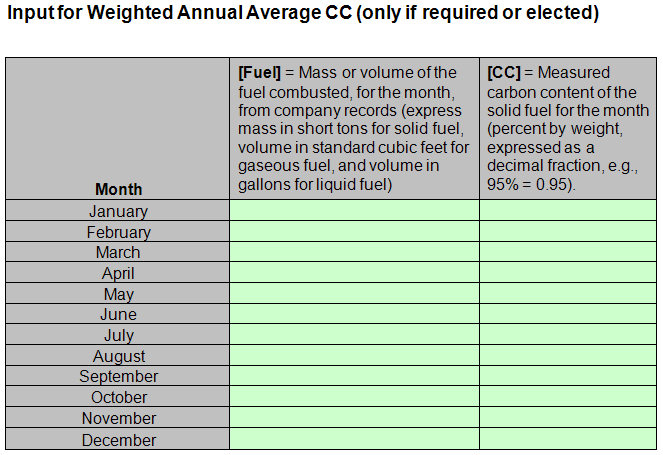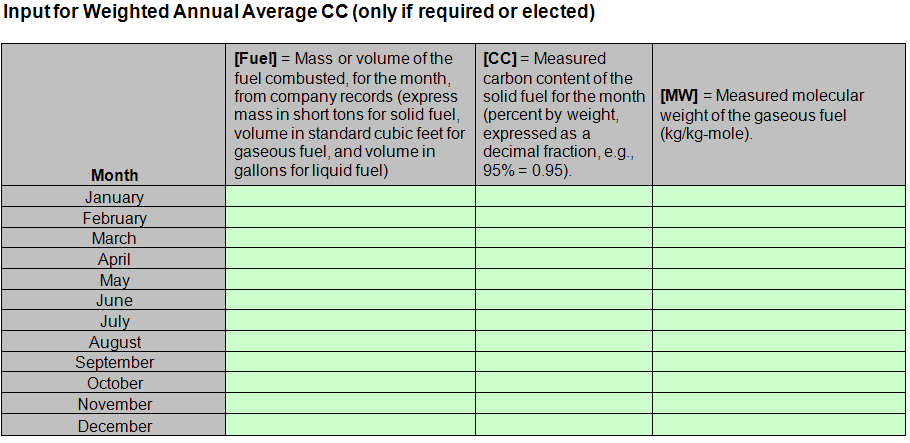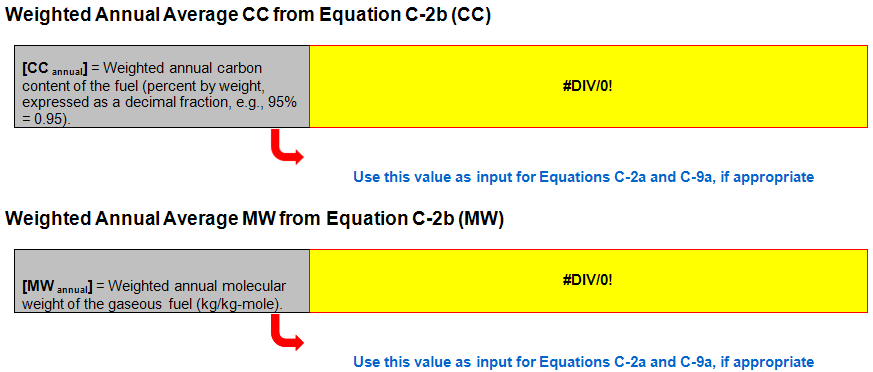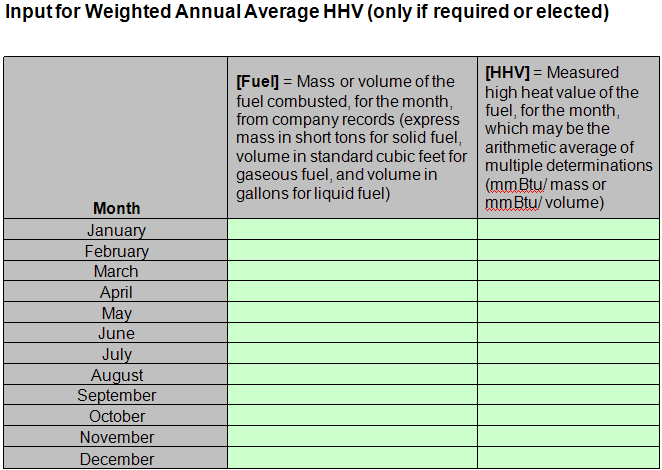This help page provides guidance for working with the supplemental subpart C calculation spreadsheets. The guidance provides step-by-step instructions for the following tasks:
- #Selecting the Appropriate Calculation Spreadsheet
- #Downloading a Calculation Spreadsheet
- General Information on Using a Calculation Spreadsheet
- Using the Equation C-2b (CC) Calculation Spreadsheet
- Using the Equation C-2b (CC and MW) Calculation Spreadsheet
- Using the Equation C-2b (HHV) Calculation Spreadsheet
Specific information on each of the calculation spreadsheets is provided below:
Calculation Spreadsheet |
Instructions |
|---|---|
Selecting the Appropriate Calculation Spreadsheet
To calculate emissions for stationary combustion units reporting under subpart C, users may use the spreadsheets described in the table below. The equations for calculating CO2 mass emissions and CH4/N2O mass emissions are combined onto one spreadsheet as appropriate. The table below describes the equation inputs, outputs, and the Tier and Cal e-GGRT configuration types in which each equation may apply. Note that some Tiers and Configurations only allow the use of a given equation for certain situations. Ultimately, the user should refer to 40 CFR 98.33(b) to determine which Tier is allowed and to 40 CFR 98.33(a) to determine which equation within a Tier is appropriate. If a configuration combusts multiple fuel types, it is possible that different tiers and different equations may be used for that given configuration. The spreadsheets are designed to account for one type of fuel, so each additional fuel combusted in a configuration will need a new spreadsheet.
Calculation Spreadsheet |
Tier |
Basis for Calculations |
Configuration |
Output(s) |
|---|---|---|---|---|
2 |
Fuel Use, Measured Fuel Carbon Content |
1, 3, 4 |
CCannual |
|
2 |
Fuel Use, Measured Fuel Carbon Content, Measured Molecular Weight |
1, 3, 4 |
CCannual |
|
2 |
Fuel Use, Measured High Heat Value |
1, 3, 4 |
HHVannual |
Tier 2 Calculation Methodology
Equation C-2b (CC) Calculation Spreadsheet
Use this spreadsheet to calculate the annual average CC emissions for a fuel combustion configuration that uses the Equation C-2b, Tier 2 calculation methodology. This spreadsheet performs the calculations using Equations C-2b (CC), which are provided below:
(Equation C-2b (CC)) |
|
|---|
Equation C-2b (CC and MW) Calculation Spreadsheet
Use this spreadsheet to calculate the annual average CC and MW emissions for a fuel combustion configuration that uses the Equation C-2b, Tier 2 calculation methodology. This spreadsheet performs the calculations using Equations C-2b (CC and MW), which are provided below:
(Equation C-2b (CC and MW)) |
|
|---|
Equation C-2b (HHV) Calculation Spreadsheet
Use this spreadsheet to calculate the annual average HHV emissions for a fuel combustion configuration that uses the Equation C-2b, Tier 2 calculation methodology. This spreadsheet performs the calculations using Equations C-2b (HHV), which are provided below:
(Equation C-2b (HHV)) |
|
|---|
Downloading a Calculation Spreadsheet
Calculation spreadsheets for subpart C may be downloaded by clicking one of the links in the first column of the table below. Users may also jump to instructions for each calculation spreadsheet by clicking one of the links in the second column.
Calculation Spreadsheet |
Instructions |
|---|---|
Using a Calculation Spreadsheet to Make Calculations
The guidance provided in this section applies to each of the calculation spreadsheets for subpart C. Additional guidance is provided for each individual calculation spreadsheet in the sections below.
Color coding
The calculation spreadsheets contain green input cells, gray informational cells, and red-bordered results cells filled with yellow or white. Users should use green input cells to enter all data specific to their facility, unit, or process. Gray informational cells contain parameter names, column and row headings, equation constants and subtotals. Calculation results are displayed in red-bordered results cells filled with yellow or white. For red-bordered, yellow-filled results cells, the values in these cells should be entered in the appropriate and separate calculation spreadsheet (as directed below cell) where additional calculations will be made. For red-bordered, white filled results cells, the values in these cells should be entered in Cal e-GGRT for the appropriate process units. All cells that are not green input cells are locked and cannot be modified.
|
Green input cell (data entry) |
|
Gray informational cells (locked) |
|
Red-bordered, yellow-filled results cells (enter in appropriate and separate calculation spreadsheet) |
|
Red-bordered, white filled results cells (enter in Cal e-GGRT) |
Stop and Warning Messages
The calculation spreadsheets will display a stop message if the user enters a value that is invalid or a warning message if the user enters a value outside the EPA estimated range for a particular data element. For invalid data entries, the stop messages will not allow a user to proceed and the user must reenter valid data before moving forward. For data entries that are outside the EPA estimated range for a particular data element, the warning messages will allow a user to proceed if the user deems the entered value to be accurate.
Multiple Configuration Types and Multiple Fuels
Users with multiple configuration types and multiple fuels should use separate calculation spreadsheets for each configuration type and for each fuel. Users should not aggregate data for multiple configuration types or fuels when using these calculation spreadsheets.
Using the Equation C-2b (CC) Calculation Spreadsheet
Use this spreadsheet to calculate the annual average CC emissions for a stationary fuel combustion configuration that uses the Equation C-2b (CC), Tier 2 calculation methodology. Use a separate spreadsheet for each configuration and for each fuel. The Equation C-2b (CC) Calculation Spreadsheet performs the calculations using Equations C-2b (CC) provided below.
(Equation C-2b (CC)) |
|
|---|
Begin by entering the facility name, your name, the configuration identifier, reporting period, and any additional comments in the green input cells of the general information table located immediately below the equation in the calculation spreadsheet. This is for your records.
Next, enter the requested information in the green input cells in the Fuel Input Data table.
The calculation spreadsheet will calculate the annual average CC emissions of fuel. The calculated values will be displayed in red-bordered cells at the bottom of the spreadsheet. These values should be entered in Cal e-GGRT for this fuel and configuration type combination.
Using the Equation C-2b (CC and MW) Calculation Spreadsheet
Use this spreadsheet to calculate the annual average CC and MW emissions for a fuel combustion configuration that uses the Equation C-2b (CC and MW), Tier 2 calculation methodology. Use a separate spreadsheet for each configuration and for each fuel. The Equation C-2b (CC and MW) Calculation Spreadsheet performs the calculations using Equations C-2b (CC and MW) provided below.
(Equation C-2b (CC)) |
|
|---|---|
(Equation C-2b (MW)) |
|
Begin by entering the facility name, your name, the configuration identifier, reporting period, and any additional comments in the green input cells of the general information table located immediately below the equation in the calculation spreadsheet. This is for your records.
Next, enter the requested information in the green input cells in the Fuel Input Data table.
The calculation spreadsheet will calculate the annual average CC and MW emissions of fuel. The calculated values will be displayed in red-bordered cells at the bottom of the spreadsheet. These values should be entered in Cal e-GGRT for this fuel and configuration type combination.
Using the Equation C-2b (HHV) Calculation Spreadsheet
Use this spreadsheet to calculate the annual average HHV emissions for a fuel combustion configuration that uses the Equation C-2b (HHV), Tier 2 calculation methodology. Use a separate spreadsheet for each configuration and for each fuel. The Equation C-2b (HHV) Calculation Spreadsheet performs the calculations using Equations C-2b (HHV) provided below.
(Equation C-2b (HHV)) |
|
|---|
Begin by entering the facility name, your name, the configuration identifier, reporting period, and any additional comments in the green input cells of the general information table located immediately below the equation in the calculation spreadsheet. This is for your records.
Next, enter the requested information in the green input cells in the Fuel Input Data table.
The calculation spreadsheet will calculate the annual average HHV emissions of fuel. The calculated values will be displayed in red-bordered cells at the bottom of the spreadsheet. These values should be entered in Cal e-GGRT for this fuel and configuration type combination.














